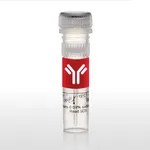
Thermo Fisher Scientific Rat MINT3 (aa 1-19) Synthetic Peptide
✨AI 추천 연관 상품
AI가 분석한 이 상품과 연관된 추천 상품들을 확인해보세요
연관 상품을 찾고 있습니다...
Applications
Tested Dilution
Publications
Control (Ctrl)
Assay-dependent
Product Specifications
Class
Synthetic
Type
Peptide
Conjugate
Unconjugated Unconjugated Unconjugated
Form
Lyophilized
Concentration
0.5 mg/mL
Storage conditions
-20° C, Avoid Freeze/Thaw Cycles
Shipping conditions
Wet ice
Product Specific Information
PEP-135 is a 19 amino acid synthetic peptide whose sequence corresponds to amino acid residues 1-19 from rat Mint3 protein. The sequence of this peptide is (amino to carboxy terminus): M (1)-E-F-L-P-E-P-Q-H-P-P-G-P-P-T-M-D-L- E (19).
This peptide may be used for neutralization and control experiments with the polyclonal antibody that reacts with this product and rat Mint3 protein, catalog # PA1-072. Using a solution of peptide of equal volume and concentration to the corresponding antibody will yield a large molar excess of peptide (~70-fold) for competitive inhibition of antibody-protein binding reactions.
Reconstitute with 0.1 mL of distilled water.
Target Information
The munc-18 interacting protein (Mint) protein family is a group of evolutionarily conserved adaptor proteins that function in membrane transport and organization. In mammals, there exist three mint isoforms, Mint1, 2, and 3. Although there is little amino acid sequence conservation in the amino-terminal half, the carboxy-terminal half of these proteins is highly conserved. Within this conserved portion there exists a phosphotyrosine-binding (PTB) and a PSD-95/DLG-A/ZO-1 (PDZ) domain, which function as protein interaction modules. Mint1 and 2 appear to be expressed exclusively in the brain and are found to bind to Munc18, an essential component of the synaptic vesicle fusion machinery. Mint3 is ubiquitously expressed in all tissues and is expressed at the lowest levels in the brain and testis. Studies show that mint3 does not interact with munc-18. Mint3 has been found to interact with the Alzheimers Disease-related amyloid precursor protein (APP) and does so through its PTB and PDZ domains. It has been suggested that mint3 links APP to other transport machinery components, thereby regulating it transport, endocytosis, and metabolism. Abnormal APP metabolism has been shown to be the cause of an early-onset type of Alzheimers disease.
For Research Use Only. Not for use in diagnostic procedures. Not for resale without express authorization.
🏷️Thermo Fisher Scientific 상품 둘러보기
동일 브랜드의 다른 상품들을 확인해보세요

Thermo Fisher Scientific
Thermo Fisher Scientific Human MYBPC1 Synthetic Peptide
195,500원

Thermo Fisher Scientific
Thermo Fisher Scientific Human CaMKI (aa 1-18) Synthetic Peptide
226,600원

Thermo Fisher Scientific
Thermo Fisher Scientific Rat MINT3 (aa 1-19) Synthetic Peptide

Thermo Fisher Scientific
Thermo Fisher Scientific Human SYTL5 Synthetic Peptide
195,500원

Thermo Fisher Scientific
Thermo Fisher Scientific Human Lass4 Synthetic Peptide
397,900원
배송/결제/교환/반품 안내
배송 정보
| 기본 배송비 |
| 교환/반품 배송비 |
|
|---|---|---|---|
| 착불 배송비 |
| ||
| 교환/반품 배송비 |
| ||
결제 및 환불 안내
| 결제수단 |
|
|---|---|
| 취소 |
|
| 반품 |
|
| 환급 |
|
교환 및 반품 접수
| 교환 및 반품 접수 기한 |
|
|---|---|
| 교환 및 반품 접수가 가능한 경우 |
|
| 교환 및 반품 접수가 불가능한 경우 |
|
교환 및 반품 신청
| 교환 절차 |
|
|---|---|
| 반품 절차 |
|
